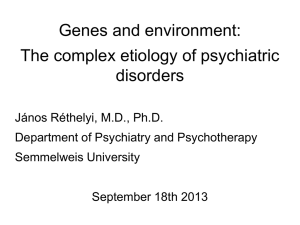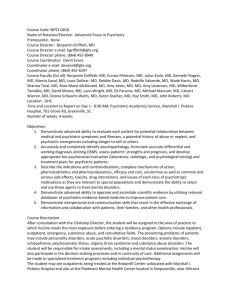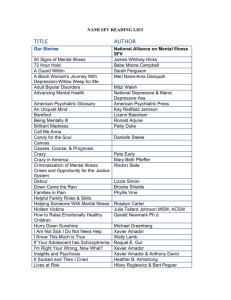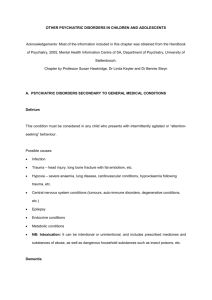Psychiatric Interview
advertisement
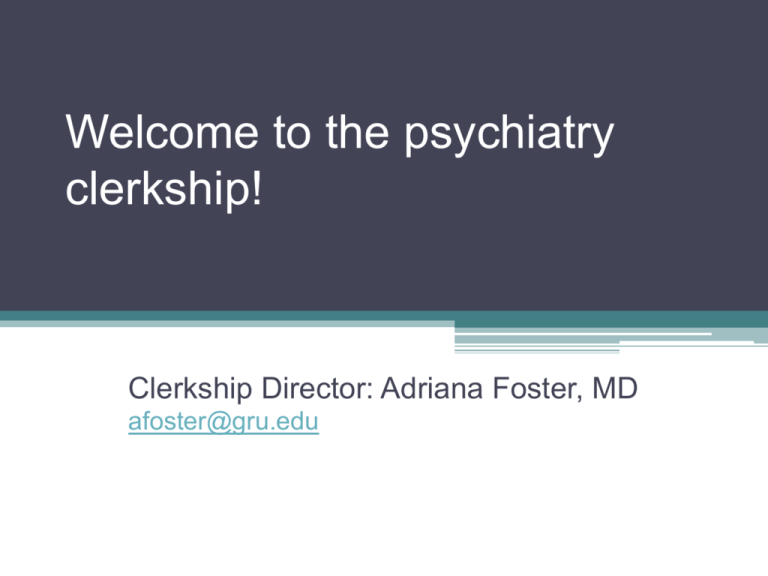
Welcome to the psychiatry clerkship! Clerkship Director: Adriana Foster, MD afoster@gru.edu Psychiatry clerkship orientation goals • Describe clerkship objectives/ expectations • Describe the resources provided on the clerkship website • Identify self-study areas • Perform: ▫ mental status exam ▫ psychiatric interview Clerkship Objectives (C.O.) C.O. 1. Patient care A.Perform a thorough psychiatric interview of a patient with mental illness B.Perform and describe a mental status examination. C.Appraise the information obtained in a psychiatric interview. D.Formulate a psychiatric differential diagnosis E.Recognize the need for clinical testing (i.e., neurocognitive disorder evaluation, diagnostic testing) F. Appraise the appropriate treatment modalities for psychiatric disorders. G.Demonstrate the ability to educate patients and their families/support systems about diagnoses, and subsequent care or mental disorders. C.O. 2 Medical Knowledge A. Recognize the pathophysiology, epidemiology, clinical picture, and principles of treatment for the following disorders: Psychiatric aspects of medical disorders Neurocognitive disorders Psychotic disorders Bipolar and depressive disorders Anxiety disorders and trauma/stressor related disorders Personality disorders Substance use disorders Childhood and adolescent psychiatric disorders B. Appraise the indications, contraindications, and possible side effects of the following drug classes in formulating a treatment plan: Antipsychotic Anti-anxiety Mood stabilizers Antidepressants Sedative/hypnotics Other drug classes that display psychiatric side effects C. Distinguish the indications for the major types of psychotherapy occurring in individual or group format: supportive; cognitive; behavioral; psychodynamic. D.Demonstrate an understanding of social history within the bio-psychosocial formulation of mental illness. E. Demonstrate an understanding of the epidemiology of suicide risk. C.O. 3 Practice-Based Learning and Improvement A. Demonstrate genuine intellectual curiosity and desire to learn, focused inquisitiveness in asking questions, and enduring persistence in the pursuit of learning. B. Choose and appraise medical literature that pertains to at least 1 (one) of their patients’ mental illness C. Complete a mid-rotation feedback form including goals for self-improvement D. Accept constructive criticism and modify behavior based on feedback. C.O. 4 Interpersonal and Communication Skills A. Give an oral presentation of a patient in a succinct and organized manner using findings from the psychiatric interview and mental status exam. B. Write complete histories and physicals and progress notes in a succinct and organized manner using findings from the psychiatric interview and physical exam. C. Communicate empathically with patients with mental illness and their families or support system members D. Communicate with others in a respectful, professional and non-judgmental manner and demonstrate effective listening skills E. Recognize barriers to communication if they occur during a psychiatric interview. F. Educate patients assuring their understanding on healthy behavior change when appropriate (i.e., substance use, treatment adherence) G. Educate patients assuring their understanding on medical risk and benefits when appropriate (i.e., medication side effects) C.O. 5 Professionalism A.Students will demonstrate utmost respect for all with whom they interact (patients and their families and support system, colleagues and team members) B.Describe the importance of protecting patient privacy and identifying personal health information, including when and when not to share information; Required institutional training and assessment C.Maintain appropriate professional appearance and composure. D.Recognize and address personal limitations, attributes or behaviors that might limit one’s effectiveness as a physician and seek help when needed. E.Demonstrates sensitivity and responsiveness to a diverse patient population, including but not limited to diversity in gender, age, race, religion, disabilities and sexual orientation. C.O. 6 Systems-based Practice A. Demonstrate the ability to work within a multidisciplinary patient care team, with an understanding of the physicians’ role as team leader and the importance of ancillary staff. B. Examine medical errors and quality problems using a health systems approach and describe available methods to minimize them. Your job during the clerkship • Enjoy every day! People will tell you amazing life stories in the next month!!! • Study from Day 1: Departmental and NBME exam can be difficult!!! • Log ALL patients seen • Observe safety and confidentiality rules • Respect/learn from your team: attending, SW, psychologists; counselors, occupational therapists, peer support specialists, nurses • Report any problems EARLY to your attending, clerkship director or coordinator. TO DO/NOT TO DO DO: Ask for contact numbers for attending/resident Arrive on time or early on wards/clinics Ask many questions Ask for feedback on your interviews and write-ups Offer to present cases or short (5 min) literature reviews Log ALL patients seen in One45 Respect and advocate for your patients NOT TO DO: Be late Call in late after you already missed part of the day Be overly familiar with patients and staff Self disclosure (with minimal exceptions) Break any confidentiality barriers Contact the site preceptor for appeals Psychiatric Interview Adriana Foster, MD = It takes some skill…. Psychiatric Interview = Skill to encourage disclosure of personal information for a professional purpose Empathy → rapport → therapeutic alliance OUTLINE OF PSYCHIATRIC CASE PRESENTATION Chief Complaint: patient’s words HPI and psychiatric history: course/treatment Psychiatric review of systems: symptoms inventory and duration Depressive and bipolar, psychosis, anxiety, obsessive-compulsive and trauma-related, substance & alcohol use, neurocognitive, neurodevelopmental, personality, and other disorders. Suicidal: thoughts, plan, intent, means (has gun?), personal and family history of suciide Dangerous Legal Medical/Family/Social history Developmental: pre-natal history/sibs/raised by/family life/events/trauma Mental status exam. Cognitive exam (for example MOCA, MMSE) in the last 5 minutes. PRESENTATION Differential diagnosis: most likely 2-3 and why?; specific examples and factors for and against R/O Depressive and bipolar, psychosis, anxiety, obsessive-compulsive and trauma-related, substance & alcohol use, neurocognitive, neurodevelopmental, personality, and other disorders Formulation: Biologic: genetic d/o/ substance/medical Psychologic: relate childhood / development to current conflicts. Social-cultural: +prognosis: function at work, hobbies, stable relationships, faith, volunteer: reflect ego strength - prognosis: poor relationships, impulsivity, bad work history, non-adherence Treatment State goals of each of the following (include patient’s goals): Medication: why / side-effects / complications / compliance problems. Therapy: individual / group supportive / insight: behavioral / cognitive / psychodynamic Chief Complaint • What brought the patient in? Patient’s own words • Why now and not 6 months ago? • What happened in the past week? • Past 24 hours? HPI: Course & treatment When started: child, adolescent, adult What led to first treatment: --Suicide attempt? ▫ Hospitalization? ▫ Who initiated it: Patient? Family? School? Legal system? Military? Social services? What worked best: medication; ECT; psychotherapy; peer groups; AA; alternative medicine? Is family or other support involved? Psychiatric review of systems = symptom inventory, sequence & duration Depressive or bipolar Psychosis Anxiety, obsessive-compulsive and trauma-related disorders Substance & alcohol use Neurocognitive disorders Other disorders: Neurodevelopmental, Somatic symptom, Factitious, Impulse control, Dissociative, Sexual dysfunctions, Feeding and Eating, Sleep-Wake, Disruptive, impulse control and conduct disorders Personality Explore temporal relationships: cause vs. co-morbidity. Ask about development • Early childhood: who raised the patient? • School years: academic –special education or high achiever, activities, drugs, legal system, missing school due to illness… • How available were the parents? • Abuse • Away from home: job, college, marriage • Relationships throughout development Ask about strengths • What did you use to enjoy before you became ill? • What are you good at? • How has your illness and its treatment affected your ▫ physical activities ▫ relationships with family and friends ▫ job and hobbies ▫ feelings about yourself ▫ spiritual/religious beliefs • What is the most difficult thing about your illness and its treatment? • Any positive experience with your illness/treatment? Interventions Affirmation =”I see” Advice/praise =“I’m so proud of you that you stopped smoking!” Empathic validation: “It hurts to be treated that way” Encouragement to elaborate: “tell me more about your mother” Clarification = pull together patient’s verbalizations into a more coherent way Confrontation = addresses something patient does not want to accept. Reflects back to patient a denied or suppressed feeling. Interpretation = one of most expressive forms of treatment; therapist’s decision making; makes something conscious that was previously unconscious. Q1: This person is dealing with: check all correct answers • • • • • Transference Financial hardship Resistance Denial Anger against therapist Q2: The therapist is offering: check all correct answers • • • • • A confrontation An interpretation Empathic validation Re-framing Encouragement to elaborate During a psychotherapy session in which the therapist has had multiple previous visits with the patient, the therapist says to the patient: “I sometimes become concerned that when I suggest you try to speak up, you may in fact speak up just for me because it is what I seem to want—the same way you always do others’ bidding and neglect your own wishes. It seems that you did this for your parents and your bosses and some of your friends as well as for me.” This statement typifies therapist comments made during: A. Psychodynamic psychotherapy B. Cognitive psychotherapy C. Supportive psychotherapy D. Group psychotherapy E. Twelve-step substance abuse programs Content vs.. Process • What information we get vs.. • How we get it …. Diagnostic vs.. dynamic • Diagnostic: happens early • Dynamic interview = extended process; elicits biopsycho-social and cultural aspects of the illness Mental Status Exam Psychiatry Chief Resident Identifying Information • • • • Age Sex Ethnicity Marital Status Orientation • • • • Person Place Time Situation Appearance & Behavior • Appearance: ▫ ▫ ▫ ▫ ▫ ▫ ▫ Apparent age Body habitus Clothing Grooming Odor Scars Tattoos/Piercings • Behavior: ▫ ▫ ▫ ▫ Toward interviewer Eye contact Attentiveness Level of consciousness Psychomotor • Retarded • Accelerated/Agitated • Involuntary movements ▫ Organic vs. medication-induced? Speech • • • • • • • • Spontaneous/Nonspontaneous Volume Rate Tone Articulation Speech latency Paucity of speech content Pressured Mood & Affect • Mood ▫ Subjective ▫ Elicited from the patient themselves ▫ Depressed, sad, dysphoric, euphoric, anxious, angry, irritable, happy, hostile… • Affect ▫ Objective – patient’s expression of mood ▫ Flat/Blunted ▫ Constricted/Restricted ▫ Full ▫ Expansive/Broad ▫ Congruent/incongruent with mood - Appropriate/ Inappropriate ▫ Labile/Stable Thought Process • • • • • • Speed: RapidSlow Linear/Goal directed/Logical Tangential Circumstantial Flight of ideas Looseness of association/ Derailment • • • • • • Incoherent/Word salad Clang associations Neologisms Perseveration Echolalia Thought blocking Thought Content • • • • • • Preoccupations Obsessions Phobias Overvalued Ideas Suicidality Homicidality • Delusions ▫ Grandiose, persecutory, somatic, nihilistic, religious, jealousy, erotomanic, culturebound, control (thought broadcasting or insertion) ▫ Mood congruent/incongruent ▫ Bizarre/Non-bizarre ▫ Ego-syntonic/dystonic Perception • Hallucinations and Illusions ▫ Sensory system: Auditory, visual (hypnogogic, hypnopompic), tactile, olfactory ▫ Depersonalization/derealization=detachment • Dreams ▫ Nightmares, recurrent dreams ▫ Fantasies, daydreaming Insight & Judgment • Insight ▫ Patient’s understanding of their illness • Judgment ▫ Examples of harmful behaviors ▫ Test an imaginary situation Stamped addressed envelope ▫ Abstraction Proverb Memory, Attention & Concentration • Serial 7’s • WORLD DLROW • Immediate and delayed recall MINI-MENTAL STATE (Folstein, 1975 – proprietary) ORIENTATION ▫ What is the (year) (season) (date) (day) (month)? ▫ Where are we: (state) (county) (town) (hospital) (floor)? REGISTRATION Temporal ▫ Name 3 objects: One second to say each. Ask the patient all three after you have said them. Give 1 point for each correct answer. Then repeat them until he/she learns all three. Count trials and record: ATTENTION AND CALCULATION Frontal ▫ Serial 7’s. One point for each correct. Stop after five answers. Alternatively spell “world” backwards. RECALL Temporal Ask for the three objects repeated above. Give one point for each correct. LANGUAGE Fronto-temporal ▫ Repeat the following “No ifs, ands or buts.” (1 pt.) Follow a 3-stage command: “Take a paper in your right hand, fold it in half, and put it on the floor” (3 pts.) ▫ Name a pencil, and watch (2 pts.) Occipital ▫ Read and obey the following: Close your eyes (1 pt.) Write a sentence (1 pt.) Copy design (1 pt.) Parietal CONSCIOUSNESS RAS Alert; drowsy; stupor ; coma. http://enotes.tripod.com/MMSE.pdf Executive function - frontal = ability to think abstractly, plan, initiate and sequence, monitor and stop complex behavior; insight, judgment Bedside measures • Luria Motor Test: alternate hand movements; fist, cut; slap. • Word Fluency Test: “tell me 5 words starting with the letter “A” • Similarities: ability to apply abstract concepts. • Proverb interpretation: conceptual thinking ability • Clock Drawing: “This circle represents a clock face. Please put the numbers, so that it looks like a clock and then set the time to 10 minutes past 11” (parietal and frontal lobes involved) 5 point scale (Shulman): 5 points: perfect clock 4: minor visual-spatial errors 3: inaccurate representation of 10 past 11 with good visual-spatial representation 2: moderate visual-spatial disorganization, such as accurate representation of 10 past 11 is impossible 1: severe visual-spatial disorganization 0: no reasonable representation of a clock http://www.m ocatest.org/d efault.asp MSE Example • ID/Appearance/Behavior: 30-something obese WM with well-groomed beard casually and appropriately dressed in sports jersey and backwards cap; cooperative with interviewer, poor eye contact; inappropriate laughter • Orientation: Not assessed, however most likely oriented to person and place at least • Psychomotor: No abnormal movements, no psychomotor agitation/retardation MSE Example (ctd.) • Speech: Spontaneous w/ normal volume, rate, tone; normal articulation • Mood: Variable – euthymic to broad at beginning, dysphoric (“life sucks”) towards end • Affect: Variable but appropriate and moodcongruent – full at beginning, restricted at end • Thought Process: + looseness of associations; + clang associations; + neologisms Psychopharmacology Basics Adriana Foster, MD Antidepressants: SSRIs Action: inhibit 5HT reuptake Side Effects: GI 5HT3 receptors activation Sexual D2, Ach blockade, 5HT reuptake inhibition Endocrine SIADH; hyponatremia more frequent in older ♀ Discontinuation sdr. Pregnancy paroxetine - class D Increased suicidal behavior in children & adolescents Serotonin syndrome with other serotonergic agents: neuromuscular-myoclonus, autonomic instability, mental status, GI symptoms CYP450 interactions: fluoxetine, paroxetine, fluvoxamine-most, citalopram and sertraline-least Antidepressants SNRIs: venlafaxine, duloxetine, desvenlafaxine BP elevation at higher dose NDRI (NE, DA reuptake inhibitor): Bupropion: dose dependent seizures; CI in eating d/o Mirtazapine: Selective α2 adrenergic antagonism with increase in serotonergic and noradrenergic activity; 5HT2c and 5HT3 receptor blockade → 5HT1A activation; sedation, weight gain, neutropenia 5HT2 antagonists/reuptake inhibitors: Nefazodone: sedation, visual trails, MANY drug interactions CYP450 3A4, hepatic failure-rare Trazodone (metabolite mCPP a strong serotonin agonist-anxiogenic and induces anorexia), priapism Antidepressants TRICYCLICS: inhibit NE and 5HT uptake and less DA Sedation, anticholinergic toxicity (treat with bethanechol), CVarrhythmias (order EKG >40 years old, avoid in heart disease) Lethal in overdose: wide-complex arrhythmia, seizure, hypotension Nortriptyline therapeutic window: 50-150 ng/ml MAOIs: Inhibit MAO-A and B which metabolize NE, 5HT and DA; nonselective-phenelzine, tranylcypromine (selective: selegiline; reversible-RIMA: moclobemide) Serotonin syndrome with SSRIs, SNRIs, triptans Hypertensive crisis with adrenergic agents, meperidine and high monoamine content foods; treat with phentolamine, chlorpromazine, nifedipine; DO NOT GIVE β BLOCKERS Require low monoamine diet GENERIC BRAND ANTIDEPRESSANT NAMES AND FDA APPROVED INDICATIONS Sertraline Zoloft Major depression,(MDD), OCD (adult and child), PTSD, social anxiety d/o, panic d/o, premenstrual dysphoric d/o (PMDD) Fluoxetine Prozac (weekly available) MDD (adults, children, adolescents), panic, OCD, bulimia nervosa, PMDD Fluvoxamine Luvox (XR) OCD Paroxetine* Paxil (CR) MDD, OCD (adult, child and adolescent), social anxiety, Generalized anxiety disorder (GAD), PTSD, PMDD Citalopam** Celexa MDD Escitalopram Lexapro MDD (adults and adolescents), GAD Venlafaxine Effexor (XR) MDD, panic, social anxiety d/o, GAD Des-venlafaxine Pristiq MDD Duloxetine Cymbalta MDD, neuropathic pain, fibromyalgia Bupropion Wellbutrin (SR, XL), Zyban MDD, Smoking cessation Mirtazapine Remeron MDD, Nefazodone n/a MDD Trazodone Desyrel MDD Phenelzine Nardil MDD Tranylcypromine Parnate Selegiline Emsam (patch), Deprenyl (oral) Amitriptyline Elavil MDD Nortriptyline Pamelor MDD Antipsychotics 1st generation DISCUSS/MONITOR RISK D2 blockade Movement d/o: Parkinsonism (at 80% blockade) treat with anticholinergics, akathisia (tx with β blockers or benzos), acute dystonia (IM antichol.), tardive dyskinesia (eliminate offending agent) NMS: rigidity, hyperthermia, tachycardia, ↑CPK, AMS, potentially lethal! – supportive measures Anticholinergic Sexual (increased prolactin) Retinitis pigmentosa: chlorpromazine and thioridazine QT prolongation black box: thioridazine Antipsychotics 2nd generation DISCUSS/MONITOR RISK Risperidone, paliperidone, olanzapine, quetiapine, ziprasidone, aripiprazole, iloperidone, asenapine D2 (also D3 and D4) , 5HT2 blockade, glutamate? Metabolic: wt gain and direct effect on triglycerides, serum leptin Sexual Movement: risperidone anticholinergic treatment Orthostatic hypotension: titrate slowly (quetiapine, iloperidone) QT prolongation: ziprasidone, iloperidone CLOZAPINE minimal D2 blockade (D1, D2, D3, D4), 5HT2A (also 5HT2C, H1, M1, α1) Five black box warnings 1. Agranulocytosis: do not give or d/c if WBC is <3,500 or ANC < 2,000, MONITOR these numbers weekly x 6mo, twice/mo x 6 mo., then monthly for lifetime 2. Cardiovascular events: myocarditis, pulmonary emboli 3. Patients with neurocognitive disorders: increased risk of death –blanket warning for ALL 2nd generation antipsychotics 4. Orthostatic hypotension 5. Seizures Advantages Indicated in refractory schizophrenia (failed ≥ 2 antipsychotics) Improvement continues long term: at 6 mo., one year and 5 years It decreases suicide risk and violence in patients with schizophrenia Along with quetiapine, used in psychosis in Parkinson’s patients because it does not induce EPS GENERIC BRAND ANTIPSYCHOTIC NAMES AND FDA APPROVED INDICATIONS Fluphenazine Prolixin (oral, IM, decanoate) Haldol (oral, IM, decanoate) Stelazine Mellaril Thorazine Risperdal (oral, long acting inj.) Schizophrenia Invega (oral, long acting inj.) Zyprexa (oral, IM, long acting injection) Schizophrenia and schizoaffective disorder Quetiapine Seroquel Schizophrenia, , acute treatment of mania and mixed episodes of bipolar d/o, maintenance tx. Of bipolar; adjunct treatment of MDD Ziprasidone Geodon (oral, IM) Schizophrenia, schizoaffective and bipolar mania (the latter indication + children 10-17) Aripiprazole Abilify (oral, IM) Iloperidone Asenapine Fanapt Saphris Schizophrenia, , acute treatment of mania and mixed episodes of bipolar d/o, maintenance tx. Of bipolar; adjunct treatment of MDD; irritability in autism; acute agitation in schizophrenia for short acting IM formulation Schizophrenia Schizophrenia, acute manic and mixed episode Clozapine Lurasidone Clozaril, FazaClo Latuda Refractory schizophrenia Schizophrenia Haloperidol Trifluoperazine Thioridazine Chlorpromazine Risperidone Paliperidone Olanzapine Schizophrenia Schizophrenia Schizophrenia Schizophrenia, MDD Schizophrenia (+ children 13-17), bipolar mania (+ children 1017)and irritability in autism; long acting risperidone is approved for schizophrenia and bipolar I disorder. Schizophrenia, acute treatment of mania and mixed episodes of bipolar d/o, maintenance tx. Of bipolar; acute agitation in schizophrenia and bipolar mania for the short acting IM injection. Adults and children over 13 years old. Mood stabilizers Lithium: Serotonin effect; Li protects rat cerebral cortex and hippocampus from glutamate induced cell death Anti-suicidal effect in bipolar d/o Side effects: Lethal in overdose: therapeutic window 0.6-1.2 MEq/L; > 3.5 mEq/l fatal Long term: hypothyroidism, renal insufficiency NSAIDs, ACE inhibitors, thiazide diuretics, tetracycline, salt restriction ↑ levels Theophylline, caffeine, osmotic diuretics ↓ levels Can use K sparing diuretics to treat nephrogenic diabetes insipidus (amiloride) Pregnancy class D: Epstein anomaly rare 1/2,000 births Mood stabilizers • Valproate ▫ Increases brain GABA levels, modulates glutamate ▫ Risk of pancreatitis and liver failure ▫ Drug interactions: increases levels of drugs metabolized through glucuronidation (lamotrigine, lorazepam) ▫ Pregnancy class D: neural tube defects (3-5% spina bifida risk ) • Lamotrigine ▫ Inhibits Na channels; stabilizes neuronal membranes; modulates glutamate ▫ Risk of Stevens Johnson sdr 3/1,000 • Carbamazepine ▫ Blocks Na channels, modifies adenosine receptors; inhibits glutamate; increases extracellular serotonin ▫ Agranulocytosis, hyponatremia, induction of other drugs’ hepatic metabolism ▫ Pregnancy class D: neural tube defects Benzodiazepine Anxiolytics GABA-A agonists Effects: Anxiolytic: anxiety, insomnia, acute agitation, withdrawal syndromes Hypnotic: useful in anesthesia Anticonvulsant: seizure control Muscle relaxation • All are pregnancy category D drugs; fetus with possible congenital abnormalities; fetus may suffer withdrawal • Dependence, tolerance, withdrawal • In patients with liver failure give lorazepam, oxazepam, temazepam metabolized by glucuronidation only Valproate Depakote (ER) Mania (mixed episodes and high number of illness manic episodes >10 predict response to valproate), migraine, seizures Carbamazepine Carbatrol, Tegretol XR, Equetro Seizures, trigeminal neuralgia and (Equetro only) manic and mixed episodes of bipolar disorder Oxcarbazepine Trileptal seizures Lamotrigine Lamictal seizures Gabapentin Neurontin Seizures, post-herpetic neuralgia Topiramate Topamax Seizures, migraine Alprazolam Xanax Diazepam Valium (oral, IV) Various benzodiazepines are approved by FDA as hypnotics, to treat anxiety disorders (panic, GAD, social anxiety), and in the case of clonazepam, as adjunct in treatment of acute mania) Lorazepam Ativan (Oral, IM, IV) Oxazepam Serax Temazepam Restoril Hydroxyzine Vistaril Benztropine Cogentin (oral, IM) Diphenhydramine Benadryl (oral, IM) Buspirone Buspar GAD Naltrexone Revia (oral, long acting injectable) Adjunct in treatment of alcoholism Disulfiram Antabuse Alcohol dependence Buprenorphine and Naloxone Suboxone Opiate dependence OTHER SOMATIC TREATMENTS • FDA approved ▫ ECT: triggers seizures in normal neurons by application of pulses of current through the scalp that propagate to the entire brain. ▫ VNS: stimulation of left vagus nerve; pulse generator in L chest wall ▫ TMS: pulsatile high-intensity electromagnetic field induces focal electrical currents in the underlying cerebral cortex • Not FDA approved Light therapy, neurosurgery in OCD, deep brain stimulation for OCD and refractory depression Foster personal EEG collection Vagus Nerve Stimulation (VNS) • FDA approved for epilepsy; FDA approved for Treatment Resistant Depression 2005 • Pulse generator implanted in left chest wall area, connected to leads attached to left vagus nerve • Mild electrical pulses applied to CN X for transmission to the brain 59 Case vignette A 28 years old man with schizophrenia is brought to the ER by family due to refusal to eat and to leave his room, agitation and paranoia. He is treated in the hospital and he is placed in a personal care home. His antipsychotic medication is changed within the month after discharge due to side effects. Within the same week he completes suicide by hanging. Suicide risk 95% of suicide completers are mentally ill: 80% have mood d/o 10% have schizophrenia 5% have delirium/dementia 25% alcohol dependence + other illness Completers: male, 40-59 yo, high lethality Attempters: ♀, <35 yo, low lethality 10% of attempters will complete suicide Native American >Caucasian> Asian >African American and Hispanic (CDC data 2012: 17.3 to 5 per 100,000 people) ↓ CSF 5-HIAA (serotonin metabolite) associated with violent suicide Suicide Risk Mood disorders: 15-20% ▫ Bipolar mixed highest risk ▫ Delusional depression Schizophrenia: 5-10% (young male, insight, high IQ, command hallucinations) ▫ 3 wks -3 mo. from hospitalization Substance abuse: ▫ Young male, multiple substances, recent loss, co-morbid, previous OD WHAT WORKS TO DECREASE RISK: LI, CLOZAPINE, ECT, psychotherapy!! SUICIDE RISK ASSESSMENT Current thoughts of suicide (IDEATION); ● Do you wish you were dead or wish that you went to sleep and not wake up? ● Do you want to die? Reasons: Is it to: ● Get attention, revenge, reaction; ● Stop the pain? Suicide plan and intent;: ● Do you have any plans? ● What plans to you have? Access to suicide means: ●Do you have a gun? Past suicide thoughts and attempt: ● Have you ever made a suicide attempt? Tried to end your life? An INTERRUPTED attempt: stopped by someone else: for example, pt holding pills in their hand, someone grabs them by the hand; noose round neck but has not started to hang and is stopped; pointed gun toward self, someone else takes the gun; An ABORTED attempt is stopped by the person after they took steps toward making an attempt PREPARATORY BEHAVIOR: did this include anything beyond verbalizing a thought? For example collecting pills, getting a gun, giving away valuables or writing a suicide note? Family history of suicide (From CDC data 2012 per 100,000 people) Major Depression Male Bipolar Depression Living alone Alcohol and drug use disorders Completers: male, 40-59 yo, high lethality Attempters: ♀, <35 yo, low lethality 10% of attempters will complete suicide Native American >Caucasian> Asian >African American and Hispanic White Schizophrenia Separated, widowed or divorced Eating disorders Unemployed or retired Antisocial personality disorder Occupation: health-related occupations higher (dentists, doctors, nurses, social workers) ; especially high in women physicians PTSD Borderline personality disorder PREVENTION: 1) Antidepressant treatment; 2) Psychotherapy: cognitive-behavioral, interpersonal or dialectic behavioral therapy; 3) Means restrictions: Firearm safety; jumping site barriers; detoxification of domestic gas; improvements in the catalytic converters in motor vehicles; restrictions on pesticides; reduce lethality of prescriptions; lower toxicity antidepressants; Medications in blister packs; Restrict sales of lethal hypnotics (i.e. Barbiturates). 65 Sources: • Allen Frances, MD, Ruth Ross, MA, DSM IV case studies, A clinical guide to differential diagnosis, American psychiatric press, 1996. • Glen O. Gabbard, MD, Psychodynamic Psychiatry in Clinical Practice, Fourth Edition, American Psychiatric Publishing, 2005. • Harold Kaplan, MD, Benjamin Sadock, MD, Kaplan and Sadock’s Synopsis of Psychiatry, 10th edition, Williams and Wilkins, 2007. • Davidson B et al, Assessment of the Family, Systemic and Developmental perspectives, Child and Adolescent Psychiatric Clinics of North America, 10(3), 415-429, 2001. • www.youtube.com • Wedding, D, Stuber, M, Behavior and Medicine, 5th edition, Hogrefe Publishing, 2010. • www.psychiatryonline.org • Posner K et al, Columbia-Suicide Severity Rating Scale from Oquendo et al Risk Factors for Suicidal Behavior: Utility and Limitations of Research Instruments, in M.B. First [Ed] Standardized Evaluation in Clinical Practice, pp. 103-130, 2003. • American Psychiatric Association, Desk Reference to Diagnostic Criteria from DSM V, APPI, 2013.

